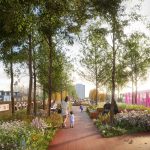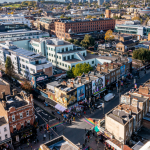Cllr Govindia is the most veteran politician we have spoken to thus far in our whistle-stop tour of the CAZ, having first been elected to Wandsworth Council in 1982. Since then, he has chaired several committees during his long career at the Council – including planning – and succeeded Sir Eddie Lister as Leader in 2011. Fast forward to the present and Govindia is London’s second longest-serving borough Leader, after Bexley’s Teresa O’Neill, having been in post for almost 11 years.
Reflecting on this long tenure, Govindia says it has been “dominated by two big challenges”: the never-ending task of shaping Wandsworth’s regeneration and most recently, tackling the pandemic. He notes that the two are unavoidably interlinked (more on this below) and confidently asserts that, on both fronts, the borough has “risen to the challenge – and got a lot of it right”.
“The bulk of my tenure” he says, “has been focused on delivering regeneration” – particularly, if not exclusively, in the wider Vauxhall, Nine Elms and Battersea Opportunity Area. Govindia points out that the planning framework for this crucial regeneration zone – which he credits to the late Sir Simon Milton – was only adopted a decade or so ago. The pace and scale of change on the ground since then almost speaks for itself.
Govindia’s pride is evident as he tells the story of how Wandsworth, working with the community, neighbouring Lambeth, TfL, the GLA, utility companies and the private sector “has delivered against that planning framework, including a £1.2bn investment in the Northern line Extension (NLE), a new town centre for Wandsworth and for London, with the Battersea Power Station at the heart of it – a Grade II* building restored and given life for another 100 years and more”. It’s been “quite a whirlwind” he says. At the start of his tenure, both the NLE and Power Station projects were in their infancy. Today, the NLE is fully operational, while Phases 1 and 2 of Battersea Power Station are already “coming to life”.
He underlines that beyond the sheer “pace of delivery”, the success of Nine Elms has gone “hand in hand with placemaking” as he passionately believes that regeneration is not simply about providing new flats, but also offering a host of things “for people to do, to visit and to be excited by”. Thanks to the NLE and other transport improvements the area’s travel links are also now excellent, supporting growth. Beyond the Power Station, Nine Elms is now dotted with a series of other new destinations, including of course the new US Embassy.
While the pandemic has had an impact on Nine Elms, as with anywhere else, he says that “it has been really refreshing to see how the community has rallied”, highlighting initiatives such as Power To Connect, which saw the Council, Battersea Power Station, St George’s Hospital and other partners join up to collect, refurbish and disseminate old laptops and tablets to help local families, NHS patients, community groups and students stay connected.
Indeed, the pandemic has only underscored the strengths of Nine Elms: aside from new homes, there are host of new businesses, shops, supermarkets and restaurants. There’s also the new linear Nine Elms park gradually taking shape, forming a vast green corridor running parallel to other public realm improvements along the riverside, plus a burgeoning cultural offering, from the new World Heart Beat Music Academy, to Matt’s Gallery The 503Studio, which will open by 2023, and a cluster of cultural assets at the Power Station. These and other elements have contributed to creating a well-rounded “work, live and play” environment.
For Govindia, the critical lessons of the pandemic, from a built environment perspective, include a renewed appreciation of how the public realm and good design can offset the pressures of “intense urban living”. Govindia insists that Wandsworth is actively taking on the challenge, through ensuring that new homes offer “room where you can both live and work” and delivering the elusive 15-minute city. “If Covid was the catalyst that helped create all that, then let’s make most of it.” he reflects.
“All of these are things that our planners wrestled with, and hopefully we will have a framework that will deliver that” – he refers, of course, to Wandsworth’s Local Plan, which is currently undergoing a review and at the fairly advanced Regulation 19 stage. He underlines that while this review began before Covid, it “has come to its final stages as we are coming out of the pandemic and is designed to live on for many years ahead”. The revised Local Plan also places a renewed emphasis on jobs and skills, culture, high quality of design and landscaping – all elements he describes as “an important part of negotiations wth developers, but also in engaging the public in the regeneration process.”
Residents must, he insists, “have a claim to regeneration and must be taken on board”. While he acknowledges that “some may feel otherwise”, the Council has “tried very hard and largely succeeded in making sure that Nine Elms is not a tale of two cities, but one of a changing city, in which residents are a part of the change and a beneficiary of it.”
Ultimately, regeneration, in Wandsworth and elsewhere, “is actually about homes and jobs – and wherever possible, ensuring new homes are close to the jobs we are creating”. He notes that in Wandsworth and further afield, “the loss of commercial, industrial and other employment land is a problem” and that decisionmakers across London “need to strike a better balance between the needs of commercial enterprise – current and future – and the need to provide new homes.”
Encouraging mixed-use development is key to that balance, particularly for high streets, which need to be “more attractive places to visit, with a diversity of choices beyond retail, whether that’s food and beverage, entertainment, leisure, childcare or professional services, which can all coalesce around the high street”. Wandsworth has invested heavily in improving the public realm in town centres across the borough, with the aim of “creating a kind of symbiosis, in which we look after the place, residents support local enterprises, and we all thrive together.”
Govindia also stresses that Nine Elms is only “a tiny part of our geography” and that for him, “it’s always been a question of spreading the borough’s energy and creativity” across its wider area. He touches upon several key focus areas for the borough beyond the CAZ, including Ram Quarter in Wandsworth Town Centre, development across the wider Thames riverside and efforts to grow its own council housing stock.
He admits that there have been challenges, pointing to improving local transport infrastructure – particularly in Wandsworth Town Centre – as a particularly knotty conundrum, expressing major frustration with TfL. He also recognises that the borough’s estate regeneration programme has had its setbacks, but insists that it has come a long way over the past decade. The council itself is investing significant sums in extensive estate regeneration programmes, including at Winstanley and York Road – which is now “well underway” – and Alton. While the latter was for a period “bogged down” it has now been “unlocked”, with Wandsworth now preparing to secure a new development partner.
Govindia stresses that success at Nine Elms and elsewhere has been the result of close partnership working. “The watchword for me is trust and both sides have to work hard to maintain that”. At the core of that, he says, “is honesty… and no surprises”. Always accepting that “developers have financial strains and councils have statutory obligations to enforce”, building and maintaining that trust means that “you can’t take a grenade out of your pocket and say ‘if you don’t do what I want I’ll pull the pin’” and that applies to both sides, he asserts, adding: “We all have to work to find solutions, to understand each other better and on the whole it has worked, because joint endeavours between the public and private sectors have led to delivering something fantastic and at some pace.”
Looking to the future, this spring brings several key milestones for Govindia as Leader, and Wandsworth Council as a whole, not least of which are setting a new budget and of course the local election on 5 May. While conceding that “every election is challenging”, he is confident about his administration’s record and his party’s prospects at the ballot box.
Govindia concludes that “every success is built on listening and delivering – both delivering what people tell us they need and sometimes leading people to the change that is necessary. We have done all of that and more, to look after the borough, but also help the borough grow and change for the better. Hopefully that is exactly what we will carry on doing for four more years following May. I have no doubts about our record of success and our enduring capacity to deliver.”
This interview was conducted by London Communications Agency on behalf of the London Property Alliance as part of its curation of the monthly Central London Planning & Politics newsletter.
Read more from our London Leaders series here.


